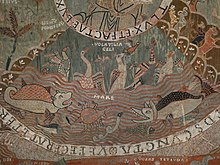Tapestry of Creation


The Tapestry of Creation or Girona Tapestry is a Romanesque panel of needlework from the 11th century, housed in the Museum of the Cathedral of Girona, Catalonia, Spain. Measuring 3.65 m × 4.70 m (12.0 ft × 15.4 ft), it originally may have served as a baldachin for the Altar of the Holy Cross in the church's entrance. Some believe that it was used as a curtain or even a carpet. It depicts a series of theological scenes related with the Christian creation narratives.
The "tapestry" is actually a panel of couched needlework laid down on the surface of the ground fabric, a terracotta wool intertwined with different colors (red, green, yellow, dark and light blue, gray) wool and white linen threads. The border is formed by a frame, rather deteriorated, containing small square pictures which, according to some scholars, could have been added later to the central sector, due to their different, Byzantine-like style and themes.
The tapestry, of which only the upper part remains, is divided into three cycles:
- the Genesis, presided over by the Christ Pantocrator
- the cosmic elements
- the Stories of the Holy Cross
The Christ Pantocrator, depicted as a beardless young man, occupies a circle in the center of the tapestry. He is surrounded by a circle whose sectors, aside from the upper one with a dove, symbol of God, show the seven days of the creation, until the creation of Adam and Eve. The two circles include quotes from the Genesis.
The remaining space in the rectangle including the central disk, houses at the corner four representation of Winds, depicted by four young winged men in Roman-like dresses, driving vessels and blowing air into horns. The central upper square is an old man representing the Year, with the wheel of time, while at the upper corners are the personifications of the Rivers of Paradise. The other six upper squares depict the Four Seasons, as well as Samson and the constellation of Hercules.[1] Each Season is visually communicated through an associated labor: in spring the land is tilled, in summer the crops are tended, in fall there is harvest, and winter is for resting by a hearth.[2]
The two lower corners show the personifications of the Sun (left, symbolizing Sunday) and the Moon (right, much deteriorated, symbolizing Monday), while the side outer squares represent the months (only eight of which survive). At the bottom are incomplete scenes of the discovery of the Holy Cross.

See also[edit]
The Bayeux Tapestry, an 11th-century, Romanesque embroidered cloth depicting events leading up to the Norman Conquest of England in 1066.
Sources[edit]
- Palol, Pere de (1992). Cataluña Medieval, Tapiz de la Creación. Barcelona: Generalitat de Catalunya. ISBN 84-393-2058-2.
- Castineiras, Manuel (2011). El tapís de la Creació / El tapiz de la Creación. Barcelona: Capítol Catedral de Girona. Girona. ISBN 978-84-930063-1-0.
- ^ "Restauració del Tapís de la Creació de la Catedral de Girona" (PDF) (in Catalan). Generalitat de Catalunya. 2012-02-03. p. 4. Archived from the original (PDF) on 2016-08-07. Retrieved 28 July 2023.
En aquest punt dels treballs de restauració s'ha descobert un tros d'inscripció gràcies a la qual s'ha pogut determinar que el personatge que fins avui es creia que representa Abel, podria fer referència a la constel·lació d'Hèrcules.
[At this point of the restoration work, a piece of inscription has been discovered after which it has been determined that the character that until today has thought to be Abel could reference the constellation of Hercules.] - ^ Baert, Barbara (1999). "New Observations on the Genesis of Girona (1050-1100). The Iconography of the Legend of the True Cross". The University of Chicago Press. 38 (2): 115 – via JSTOR.
External links[edit]
- Official cathedral's website (in English, Catalan, Spanish, and French)
- Page with details of the figures (in English)
- Page with links to websites and the newest literature (2012) (in English)
- The Art of medieval Spain, A.D. 500-1200, an exhibition catalog from The Metropolitan Museum of Art Libraries (fully available online as PDF), which contains material on Tapestry of Creation (no. 159) (in English)
